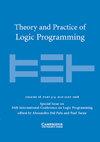Utilizing Treewidth for Quantitative Reasoning on Epistemic Logic Programs
IF 1.1
2区 数学
Q3 COMPUTER SCIENCE, SOFTWARE ENGINEERING
引用次数: 4
Abstract
Abstract Extending the popular answer set programming paradigm by introspective reasoning capacities has received increasing interest within the last years. Particular attention is given to the formalism of epistemic logic programs (ELPs) where standard rules are equipped with modal operators which allow to express conditions on literals for being known or possible, that is, contained in all or some answer sets, respectively. ELPs thus deliver multiple collections of answer sets, known as world views. Employing ELPs for reasoning problems so far has mainly been restricted to standard decision problems (complexity analysis) and enumeration (development of systems) of world views. In this paper, we take a next step and contribute to epistemic logic programming in two ways: First, we establish quantitative reasoning for ELPs, where the acceptance of a certain set of literals depends on the number (proportion) of world views that are compatible with the set. Second, we present a novel system that is capable of efficiently solving the underlying counting problems required to answer such quantitative reasoning problems. Our system exploits the graph-based measure treewidth and works by iteratively finding and refining (graph) abstractions of an ELP program. On top of these abstractions, we apply dynamic programming that is combined with utilizing existing search-based solvers like (e)clingo for hard combinatorial subproblems that appear during solving. It turns out that our approach is competitive with existing systems that were introduced recently.利用树宽度对认识逻辑程序进行定量推理
摘要通过内省推理能力扩展流行的答案集编程范式在过去几年中受到了越来越多的关注。特别注意认识逻辑程序(ELP)的形式主义,其中标准规则配备了模态运算符,这些运算符允许在文字上表达已知或可能的条件,即分别包含在所有或某些答案集中。ELP因此提供了多个答案集集合,称为世界观。到目前为止,将ELP用于推理问题主要局限于世界观的标准决策问题(复杂性分析)和枚举(系统开发)。在本文中,我们采取下一步行动,以两种方式为认识逻辑编程做出贡献:首先,我们为ELP建立定量推理,其中对某组文字的接受程度取决于与该组文字兼容的世界观的数量(比例)。其次,我们提出了一种新的系统,它能够有效地解决回答此类定量推理问题所需的潜在计数问题。我们的系统利用了基于图的度量树宽度,并通过迭代查找和细化ELP程序的(图)抽象来工作。在这些抽象之上,我们将动态编程与利用现有的基于搜索的求解器(如(e)cliso)相结合,用于求解过程中出现的硬组合子问题。事实证明,我们的方法与最近引入的现有系统相比具有竞争力。
本文章由计算机程序翻译,如有差异,请以英文原文为准。
求助全文
约1分钟内获得全文
求助全文
来源期刊

Theory and Practice of Logic Programming
工程技术-计算机:理论方法
CiteScore
4.50
自引率
21.40%
发文量
40
审稿时长
>12 weeks
期刊介绍:
Theory and Practice of Logic Programming emphasises both the theory and practice of logic programming. Logic programming applies to all areas of artificial intelligence and computer science and is fundamental to them. Among the topics covered are AI applications that use logic programming, logic programming methodologies, specification, analysis and verification of systems, inductive logic programming, multi-relational data mining, natural language processing, knowledge representation, non-monotonic reasoning, semantic web reasoning, databases, implementations and architectures and constraint logic programming.
 求助内容:
求助内容: 应助结果提醒方式:
应助结果提醒方式:


